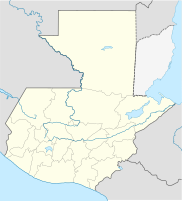Panzós
| Panzós | ||
|---|---|---|
|
Coordinates: 15 ° 24 ′ N , 89 ° 38 ′ W Panzós on the map of Guatemala
|
||
| Basic data | ||
| Country | Guatemala | |
| Department | Alta Verapaz | |
| City foundation | October 11, 1861 | |
| Residents | 44,770 (2002) | |
| - in the metropolitan area | 4,000 | |
| Detailed data | ||
| surface | 537 km 2 | |
| Population density | 83 inhabitants / km 2 | |
| height | 18 m | |
| Waters | Río Polochic , Río Cahabón | |
| Post Code | 16007 | |
| Time zone | UTC −6 | |
| City patron | Santa Rosa de Lima (festival: August 22nd to September 3rd) | |
Panzós is a place in Guatemala and the administrative seat of the municipality of the same name in the Alta Verapaz department . Around 60,000 people live in the 537 km² municipality, and around 5,000 in Panzós.
geography
Panzós is located in the south-eastern lowlands of Alta Verapaz at an altitude of about 20 m. The municipality stretches between the Sierra de Santa Cruz in the north and the Sierra de las Minas in the south in the valley of the Río Polochic , which opens near Panzós to the east to the Izabal Lake . In the eastern part of the municipality the Polochic Delta begins with its wetlands , which are home to numerous bird and reptile species. In Panzós a smaller part of this area is under nature protection, the larger part is in neighboring El Estor .
The climate in the valley is characterized by the tropical lowlands of Izabal , in the mountain areas it is more moderate.
The municipality of Panzós borders in the north on the municipality of Santa María Cahabón , in the northwest on Senahú , in the west on Santa Catalina La Tinta , in the south and southwest on the departments El Progreso and Zacapa and in the east on Izabal .
population
Originally the area was populated by Pocomchí and Kekchí . Today the population consists of more than 90 percent Kekchí, plus a few smaller Maya communities and Ladinos . A small part of the population is descended from German immigrants. The municipality consists of over 200 smaller villages and settlements, of which Telemán in the west and Cahaboncito in the northeast are the most important.
history
According to some sources, the municipality of Panzós was founded in 1825, but according to official reports it was not founded until October 11, 1861. At times it belonged to Izabal, and in 1891 it definitely came to Alta Verapaz. On November 11, 1999, the subordinate Aldea Santa Catalina La Tinta was separated from Panzós in the west and raised to an independent municipality.
Around 1865 the immigration of Germans began in Panzós and Alta Verapaz, who settled here as farmers and mainly grew coffee . The government of Guatemala endowed the German immigrants with numerous privileges and allocated them expropriated land. In 1890 almost all coffee production in the area was in German hands. The export of agricultural products from Alta Verapaz to the German Reich ran almost exclusively through the Polochic Valley, Lake Izabal and the Río Dulce to Livingston on the Caribbean coast of Guatemala and from there across the Atlantic. In return, this traffic route was used to import goods from Germany. It was soon discovered that the Río Polochic was navigable from Panzós and a small port was built there. 1895 between the jetty at Panzós and the west village Pancajché at Tucurú of the Ferrocarril Verapaz y Agencia del Norte Limitada , a nearly 50 km long with German capital and expertise railway line built. The transports to and from the few train stations were carried out with ox carts . In 1943 the railway line was nationalized, and in 1965 operations ceased.
Panzós was severely affected several times by the Guatemalan civil war . It gained notoriety because of a massacre that took place here at the end of May 1978 ( Panzós massacre ).
Economy and Transport
The traffic route through the Polochic Valley to Lake Izabal and further to the Caribbean has been one of the most important trade routes in Guatemala for centuries. Therefore Panzós was very cheap for a long time. This changed, however, with the construction of the CA 9 Atlantic Highway, which runs from Guatemala City a little further south through the Río Motagua valley to Puerto Barrios . Panzós is now off the main traffic routes. At El Rancho, the well-developed CA 14 branches off the Atlantic trunk road CA 9 to the north in the direction of Alta Verapaz. In its southernmost Municipio Tactic , near San Julian, the winding and partly unpaved national road 7 leads east through the Polochic Valley to Izabal . This way, it is around 290 km from Panzós to Guatemala City and almost 130 km to Cobán , the capital of Alta Verpaz. At the regional level, Panzós has largely lost its status as an important trading center in the Polochic Valley to the neighboring village of Telemán. Panzós is the starting point for tourists for trips through the Polochic Delta to Lake Izabal. Rafting trips on the Río Cahabón , which flows into the Polochic from the north , often end at Cahaboncito, but are also continued as far as Lake Izabal.
literature
- Julieta Sandoval: Germany en la Verapaz. In: Prensa Libre, June 24, 2005, D18-21
Web links
- Tourist information (span.)
- History of the municipality (span.)
